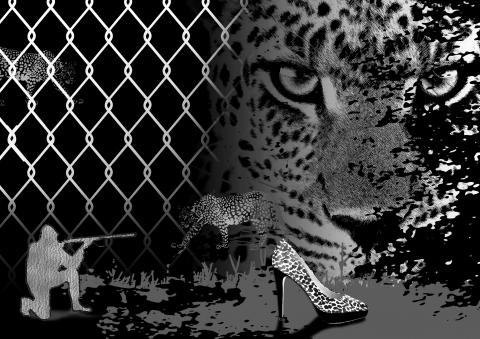The rising trade in cheetahs to serve as luxury pets in the Middle East is helping to drive critical populations of the wild cats to extinction, new research shows. The report from the Convention on the Trade in Endangered Species (CITES) also reveals the deadly costs of the trade, with up to two-thirds of the cheetah cubs being smuggled across the war-torn Horn of Africa dying en route. However, the nations at both ends of the trade have now agreed that urgent action is needed.
Cheetahs, famous as the world’s fastest land animal, have lost about 90 percent of their population over the past century as their huge ranges in Africa and Asia have been taken over by farmland. Fewer than 10,000 remain, and numbers are falling.
There is an ancient tradition of using trained cheetahs as royal hunting animals in Africa, but more recently, a growing demand for status-symbol pets in the Persian Gulf states has further reduced populations.

Illustration: June Hsu
Cheetahs are unusually easy to tame, especially as cubs, and the report found instances of the big cats riding as car passengers, being walked on leashes and even being exercised on treadmills in Persian Gulf states.
Other evidence showed cheetahs pacing around living rooms and tussling with their owners, including young children.
“This whole trade had not been appreciated by the public or by the conservation world,” said Nick Mitchell, who contributed to the report, the first comprehensive overview of the cheetah trade.
“If we do not act now on the trade and land-use changes, then we can be certainly losing sub-populations in a few years,” he said.
Cheetahs do not breed easily in captivity. The Gulf pet trade is supplied with animals snatched from the wild in the Horn of Africa. The distinct subspecies living there numbers about 2,500. The animals are trafficked by boat from Somalia to Yemen and then by road into the Gulf states, including Saudi Arabia.
“Huge number of cheetahs appear to die in transit,” said Mitchell, who is the eastern African coordinator of the Rangewide Conservation Program for Cheetah and African Wild Dog, a joint project of the Zoological Society of London and the Wildlife Conservation Society.
“For sure, we are talking about very poor people in the Horn of Africa, and they are not too worried about the welfare of the animals,” he said.
The seizures often snare 30 cheetah cubs, with an estimated 50 to 70 percent dying along the way. There is also a demand for cheetah-skin shoes in Sudan, where they are considered to confer high status.
Even more threatened is the cheetah subspecies in Iran, where just 40 to 100 survive that may also be endangered by the pet trade. Another seriously threatened subspecies lives in North and West Africa, numbering fewer than 250. There the main threat is from demand for skins for clothing and for bones and body parts used in traditional medicine and magic rituals.
The largest surviving cheetah population — about 6,200 — is in Southern Africa. Trophy hunting, costing US$10,000 to US$20,000 per animal, is allowed in Namibia, Botswana and Zimbabwe, totaling more than 200 kills per year.
In South Africa, about 90 live captive-bred cheetahs a year are exported to zoos, although conservationists worry that illegal animals could be passed off as these legally traded cheetahs.
The South African government says it is moving towards creating cheetah stud books to enable DNA profiling.
Mitchell said that he was “cautiously optimistic” that a new CITES working group, set up in reponse to the report’s revelations, would curb the illegal trade in cheetahs with better law enforcement.
“The countries were told ‘You cannot ignore it: This is being monitored,’” he said.
David Morgan, head of science at CITES, said: “Middle Eastern countries spoke up very clearly and this has been a positive development. Qatar, the Emirates, Kuwait all recognized the problem.”
Morgan said that the demand for endangered species, including big cats, was showing a trend from “health to wealth,” or a growing emphasis on status symbols over traditional medicines.
“Many Asian countries still want the trade in medicinal products, but the more ‘show-off’ element seems to be rising,” he said. “It comes with the rising economies of these countries and that drives up demand. But there are so very few animals left in the wild that they cannot afford a big rise in demand.”
A recent CITES summit that ended on Friday in Switzerland also acted on the elephant poaching crisis.
“Thailand has been given a last warning,” Morgan said. “They have been put on notice that they have to put their house in order or there will be consequences.”
Unless it acts on its domestic ivory trade, a key part of the ivory chain from Africa to China, Thailand is to be barred from trade in all flora and fauna covered by the international CITES agreement, including the lucrative orchid and cacti trades.
Interpol estimates the illegal wildlife trade to be worth US$10 billion to US$20 billion a year, the fourth most lucrative black market after drugs, people and weapons.
It is already at a scale where it harms people and nations, especially in Africa, with CITES Secretary-General John Scanlon telling the Guardian last year: “It increasingly involves organized crime syndicates and in some cases rebel militia. This poses a serious threat to the stability and economy of affected countries and robs them of their natural resources. They must be stopped.”
“The UN Security Council have linked the Lord’s Resistance Army to ivory smuggling in the Democratic Republic of the Congo, while the al-Shabaab group has been linked to illegal ivory in Somalia,” he said.

As the Chinese Communist Party (CCP) and its People’s Liberation Army (PLA) reach the point of confidence that they can start and win a war to destroy the democratic culture on Taiwan, any future decision to do so may likely be directly affected by the CCP’s ability to promote wars on the Korean Peninsula, in Europe, or, as most recently, on the Indian subcontinent. It stands to reason that the Trump Administration’s success early on May 10 to convince India and Pakistan to deescalate their four-day conventional military conflict, assessed to be close to a nuclear weapons exchange, also served to

The recent aerial clash between Pakistan and India offers a glimpse of how China is narrowing the gap in military airpower with the US. It is a warning not just for Washington, but for Taipei, too. Claims from both sides remain contested, but a broader picture is emerging among experts who track China’s air force and fighter jet development: Beijing’s defense systems are growing increasingly credible. Pakistan said its deployment of Chinese-manufactured J-10C fighters downed multiple Indian aircraft, although New Delhi denies this. There are caveats: Even if Islamabad’s claims are accurate, Beijing’s equipment does not offer a direct comparison
After India’s punitive precision strikes targeting what New Delhi called nine terrorist sites inside Pakistan, reactions poured in from governments around the world. The Ministry of Foreign Affairs (MOFA) issued a statement on May 10, opposing terrorism and expressing concern about the growing tensions between India and Pakistan. The statement noticeably expressed support for the Indian government’s right to maintain its national security and act against terrorists. The ministry said that it “works closely with democratic partners worldwide in staunch opposition to international terrorism” and expressed “firm support for all legitimate and necessary actions taken by the government of India
Taiwan aims to elevate its strategic position in supply chains by becoming an artificial intelligence (AI) hub for Nvidia Corp, providing everything from advanced chips and components to servers, in an attempt to edge out its closest rival in the region, South Korea. Taiwan’s importance in the AI ecosystem was clearly reflected in three major announcements Nvidia made during this year’s Computex trade show in Taipei. First, the US company’s number of partners in Taiwan would surge to 122 this year, from 34 last year, according to a slide shown during CEO Jensen Huang’s (黃仁勳) keynote speech on Monday last week.